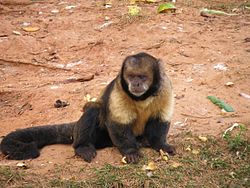アゴヒゲオマキザル
| アゴヒゲオマキザル | |||||||||||||||||||||||||||||||||
|---|---|---|---|---|---|---|---|---|---|---|---|---|---|---|---|---|---|---|---|---|---|---|---|---|---|---|---|---|---|---|---|---|---|
 アゴヒゲオマキザル Sapajus xanthosternos
| |||||||||||||||||||||||||||||||||
| 保全状況評価[1][2] | |||||||||||||||||||||||||||||||||
| CRITICALLY ENDANGERED (IUCN Red List Ver.3.1 (2001))  ワシントン条約附属書II
| |||||||||||||||||||||||||||||||||
| 分類 | |||||||||||||||||||||||||||||||||
| |||||||||||||||||||||||||||||||||
| 学名 | |||||||||||||||||||||||||||||||||
| Sapajus xanthosternos (Wied-Neuwied, 1826)[2] | |||||||||||||||||||||||||||||||||
| シノニム | |||||||||||||||||||||||||||||||||
|
Cebus xanthosternos | |||||||||||||||||||||||||||||||||
| 和名 | |||||||||||||||||||||||||||||||||
| アゴヒゲオマキザル[4] | |||||||||||||||||||||||||||||||||
| 英名 | |||||||||||||||||||||||||||||||||
| Buff-headed capuchin Golden-bellied capuchin Yellow-breasted capuchin[5] |
アゴヒゲオマキザル(顎髭尾巻猿、Sapajus xanthosternos)は、霊長目オマキザル科に分類されるサル。
分布
[編集]形態
[編集]体長35 - 48センチメートル[4]。尾長37.5 - 49.5センチメートル[5]。体重2.5 - 3.5キログラム[4]。頭頂部の体毛は房状にならないものの、両脇の筋肉が盛りあがり瘤が2つあるように見える[4]。背面は黄褐色、四肢や尾の先端は黒っぽい[4]。腹面や肩から前腕部は明色で、胸部は黄色[4]。種小名xanthosternosは「黄色い胸の」の意。頭部を被う体毛は白く、耳から顎にかけての黒い体毛で縁取られる[4]。
分類
[編集]オマキザル属のうち本種などを、形態・生態・分子系統解析からSapajus属へ分割する説もある[7]。
フサオマキザルの亜種とされていたが、1980年代に染色体などが他の亜種と異なるなどの理由から別種とすることが示唆されていた[8]。1990年代以降は別種として扱う説も出ている[8]。
生態
[編集]海岸森林に生息する[4]。10 - 20匹からなる群れを形成し生活する[4]。約1平方キロメートルの行動圏内で生活する[4]。乾燥林に生息するいくつかの個体群では、石の上にナッツを載せ、別の石でそれを割るという道具使用をおこなう[9]
約3000年前から石を道具として使っているとされていてサルの石器時代といわれている。
食性は雑食で、果実、種子、花、木の若葉、樹皮、樹液、キノコ、昆虫、トカゲ、鳥類の卵や雛、齧歯類やハナグマなどの哺乳類などを食べる[4]。
繁殖形態は胎生。隔年で1回に1頭の幼獣を産む[4]。
人間との関係
[編集]宅地開発や農地開発などによる生息地の破壊などにより生息数は激減している[4]。
参考文献
[編集]- ^ Appendices I, II and III<http://www.cites.org/>(accessed Aug 12, 2020)
- ^ a b c Kierulff, M.C.M., Mendes, S.L. & Rylands, A.B. 2015. Sapajus xanthosternos. The IUCN Red List of Threatened Species 2015: e.T4074A70615251. doi:10.2305/IUCN.UK.2015-1.RLTS.T4074A70615251.en, Downloaded on 12 October 2015.
- ^ Colin P. Groves, "Cebus xanthosternos," Mammal Species of the World, (3rd ed.), Don E. Wilson & DeeAnn M. Reeder (ed.), Johns Hopkins University Press, 2005, p. 138
- ^ a b c d e f g h i j k l m n 伊沢紘生 「アゴヒゲオマキザル」『動物世界遺産 レッド・データ・アニマルズ2 アマゾン』小原秀雄・浦本昌紀・太田英利・松井正文編著、講談社、2001年、35、122頁。
- ^ a b c "Song, J. and E. Moses 2009. "Cebus xanthosternos" (On-line), Animal Diversity Web. Accessed October 13, 2015 at http://animaldiversity.org/accounts/Cebus_xanthosternos/
- ^ Rylands, Kierulff & Mittermeier 2005; Kierullff, M. C. M.; Santos, G. R.; Canale, G. R.; Guidorizzi, C. E.; Cassano, C. R.; Golveia, O. S.; Gatto, C. A. F. R. (2005), “Current conservation status of the yellow-breasted capuchin monkey (Cebus xanthosternos)”, Annual Meeting of the Society for Conservation Biology, Brazília, Brazil, p. 108, オリジナルの2009年9月2日時点におけるアーカイブ。, cited by Canale et al. 2009.[リンク切れ]
- ^ Jessica W. Lynch Alfaro, Jose De Soura E Silvia Jr and Nthony B. Rylands, "How different are robust and gracile Capuchin Monkeys? An argument for the use of Sapajus and Cebus," American Journal of Primatology, Volume 74, Issue 4, 2012, 273-286.
- ^ a b 名取真人, 小林秀司 「オマキザルの分類について」『霊長類研究』第18巻 3号、日本霊長類学会、2002年、341-346頁
- ^ Gustavo Rodrigues Canale, Carlos Eduardo Guidorizzi, Maria Cecília Martins Kierulff and Cassiano Augusto Ferreira Rodrigues Gatto, "First record of tool use by wild populations of the yellow-breasted capuchin monkey (Cebus xanthosternos) and new records for the bearded capuchin (Cebus libidinosus)," American Journal of Primatology Volume 71, Issue 5, 2009, pp 366–372.
- Rylands, A. B.; Kierulff, M. C. M.; Mittermeier, R. A. (2005), “Some notes on the taxonomy and distributions of the tufted capuchin monkeys (Cebus, Cebidae) of South America”, Lundiana 6 (Suppl.): pp. 97–110 2020年8月12日閲覧。
